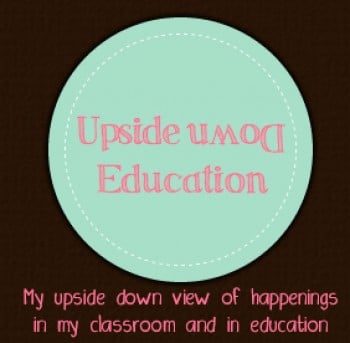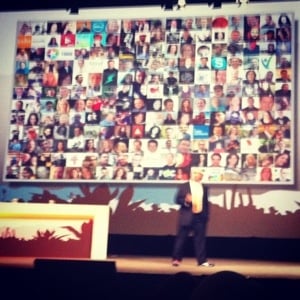
On a plane flying home from #iste13. I’m tired, my body hurts (I am reminded why I have a special made bed as well as why you should not do as Taylor Swift says and act 22, especially when you are 32), and my brain is fried. Usually when I leave a conference I have to decompress all I learned. Not this trip. No matter how bad or good a session was or how long I was in the expo all or who I was having a convo with the same thing always kept popping up in my head. The best part, the closing keynote took all of those thoughts and wrapped them in a pretty blue box and put a bow on top.
So inside this beautiful package was this: *in movie preview man voice* THE GREATEST EDUCATIONAL DISCOVERY! A TOOL THAT WILL CHANGE YOUR TEACHING! REMEMBER THIS TOOL BECAUSE IT IS ALL YOU NEED! So are you ready to know what that tool was? It is …wait for it… PEOPLE!
Yeah that is pretty simple, huh? People. The number one most important thing in education today is people. Students, teachers, admins, coaches, and even custodians. I know, it is pretty complicated tool. The learning curve can be great at times, like can be larger than the MS Surface but if you use the LOVE operating system it usually has a good tech support.
You see if our biggest focus ever becomes tools (and the way ISTE approves more tools/apps sessions than sessions that cause higher level thinking, opinion making, and problem solving on our part as attendees looks like that is where we are headed) and what’s the newest gadgets, we are going to have some major issues with our future generations. Why even have kids? Maybe we could just make kid robots that use tools. Ok so that was a little extreme and snarky. But it terrifies me to walk through the Expo hall and see adults pushing each other and screaming because they want to win a handheld fan. Like they have those on the dollar aisle at Target. It terrifies me watching teachers sit through hour long lectures listening to marketing majors tell them how their products will transform their classroom. It terrifies me when I talk to people I respect and hear their amazing presentation proposal were turned down to make room for more web 2.0 tools or apps sessions. Maybe that session on metacognition of a particular age group and how to use tech to support that is more important than being able to put a cartoon hat on a photo of a cat.
I know it is a tech conference and the majority of us geek out on this stuff but we cannot lose focus that the reasons to put technology in the hands of teachers and students is to enhanced learning and connect with (wait for it…here is that tool again) PEOPLE. When the OLPC initiative started years ago there was thing that made these stand out, not the games or apps, it was the mesh system. Those not familiar, it allowed the computers to connect to other computers, think walkie-talkie : telephone ratio comparison to mesh : internet. You are close enough to connect to computer B who is close enough to connect to C who connects to D, all can then form a mesh or a net like connection. Anyway back to point, the goal was to connect PEOPLE, more specifically children, in places without internet. Again, it’s that connecting with others that is important.
Technology is just this small medium that allows us to make those connections. I still think using twitter or whatever your choice social media to sit next to the smart kids is only going to enhance your life as well as your learning. So let’s do that as well as teach our students to do that. Meeting people face to face is still important. It is the formation of relationships, it’s the conversations, the push back and disagreements. It’s the coffee shop culture that I’ve written about that pushed Austria to be an intellectual and artistic leader prewar. Most of the strong connections I mde this week were with people I kind of knew online. Some I didn’t even know had a twitter account. But their conversations pushed me to think more than any other session. I seriously missed 4 sessions I planned to go to because I started talking to people. We spent a lot of time sitting at this high top desk that people kept mistaking for an “info” desk. We figured out how to newer almost every questions. My freakish GPS programmed in my brain came in handy. But it started so many awesome conversations!
So my point of all this, before you get excited about that new gadget, ask yourself this, does it put your students or even you first? Does it focus on humans? Does it enhance lives and/or learning or is it cool? The coolest thing about people, we are all different. We AREN’T all gamers no matter what a keynote says, but we are people who have different passions, different needs, different futures. Our job is not to entertain or get their attention or make them good test takers, our job is to be people with people. Show empathy. Show love. Listen. The key to keeping that tool PEOPLE from crashing is just listening and allowing it to operate using those different passions by meeting the needs and preparing them for their futures.



Great post Amanda! Listening, asking questions, building relationships – all more important than any tool and the key to learning. Thanks for the reminder! @dannymaas
Amanda, thanks for this post! As a person who loves to geek out, myself, you raise the same questions and concerns that have been floating around in my head. We need to keep the students first in everything we do. Relationship building and teaching students to care about each other, their community, country and the world should be our focus. Yes, digital tools make that easier than ever, but what so we really need to make that happen besides high-speed Internet connectivity? When is enough, enough? I want to see how teachers and students are connecting with each other. What are they doing when they connect? Basic, I know, but you are so right, it is the PEOPLE that matter. Maybe ISTE should experiment with a strand that is just called PEOPLE (or something like that). Probably not enough money in that, and it is after all a technology conference and the sponsors are in it to sell products and services. On the other hand, if teachers don’t find what they are looking for at ISTE, will they keep attending? Thanks, again, for pointing out one of the elephants in the convention center.
In the list of people, don’t forget parents. I think they have some influences on student learning.
I would love to have permission to repost your post on our blog or include you as a guest blogger. http://sriettcnj.blogspot.com/ Your perspective on ISTE is so valuable. As Technology Integration trainers we strive to make sure that the value of a tool is determined by the necessity of its use to achieving our goals.
Mitch, you are correct! Parents are a huge part of it, regret I did not add that! Thank you for point that out!
Michelle, yes you can repost. If you do, can you please be sure at some point to add a link back to here? Thanks!
I could not agree more. Seeing my own picture top left was such a crazy feeling in what I considered an amazing Keynote! It was such a blaring message that we are all a small part of something really big. We are, not our apps, not our devices. Well said Amanda!
Keep preaching, sister!
In his book, “Cognitive Surplus”, Clay Shirky reminds us that we once used to memorize telephone numbers not for the fun of memorizing a bunch of numbers, but because it connected us with another person on the other end. That, to me, is exactly why I love tech and HOW it is and will continue changing our profession.
I currently teach in a 1:1 (iPad) district and am a tech. integration consultant at the high school. During our first year, we spent quite a bit of time discussing how these new devices can be implemented into the classroom with apps; however, what’s more important than anything is seeing that learning is beginning to shift all because students are connecting with other students and finding real world audiences to share their work with rather than just their teacher. In fact, a colleague of mind refuse to call an application an “app” because she believes it deadens the purpose of the tool.
I am beyond impressed with this post! Thank you for giving me the reminder! Keep at it!
Amanda,
I couldn’t agree more! You very eloquently said what I tried to get across in my post the other day http://thinkshareteach.blogspot.com/2013/06/the-iste-13-vibe-lets-reconnect.html
I really felt like there was this push to hurry to sessions, and not focus on people. You hit the nail on the head.
I’m also definitely on board with your tweet during the opening keynote about not buying that we’re all gamers. I was thinking it, but wasn’t brave enough to put it out there. Nice job!
Farrah
Hey Amanda,
Speaking of people, I regret not stopping by to say hi the first moment I saw you in the bloggers cafe – I was busily going from one place to another and figured I’d see you again – but I never did:(
Thanks for a thoughtful post. I’m feeling the same way – the more I cover technology, the more it’s boiling down to people and relationships. The tools are great and engaging and when used well, they can be show stoppers, but without a person at the helm, the ship goes down. Awesome reminder of the power of people. Glad you’re in my PLN!
-Buzz
Thanks for saying so well what I’ve been believing for so long. it’s never benn about the tools but the learning that goes on by using the tools. Learning has always and always will be a social endeavor and if the tech should disappear learning would still go on because of the people – just at a less exponential level. Keep writing about this and perhaps people will help create a new disruption!
What an outstanding post, Amanda! I’m going to share it with the “people” at my school. As we continue to talk about the new tools to buy or the new apps to use to support learning, I think that we should ensure that our focus is on the students. Sometimes this is hard to do: I know this because I’ve made this mistake before. Your questions in your last paragraph though are the ones that I want to highlight, bold, and underline. They’re the ones that we should be asking every single time, and they’re the ones that I’m going to ensure that I ask from now on.
Thanks Amanda!
Aviva
Wow, you so hit the nail on the head. I am where I am today because of the PEOPLE and the connections I have with those PEOPLE. Yes, I use technology as a tool to help my young learners have their voices heard, but even then it’s about people listening and learning with others. If you took away all the technology from my classroom I’d still find ways to have my young learners connect and learn with other young learns.
If you get a chance to read my reflections of my time at ISTE it is should be very obvious that the BEST part of my time at ISTE was the PEOPLE I connected with. I’m sorry I didn’t come over and say hello when I say you. K
Amanda,
Great post.
I was at ISTE from Friday noon until Wednesday morning and didn’t attend a single session (presented several times though). Basically walked through the exhibit hall, going up and down each isle only stopping to talk to specific vendors we deal with and that I had questions for.
What I did during the was connect with people. Starting with HackED on Saturday, the ISTE Photo Walk on Sunday, visiting with old friends and making new friends during the day, and meeting up with people in the evenings. I get much more out of conversations with people than I do by attending sessions – and my PLN fills me in on the good stuff that they find in their sessions.
I enjoyed your thoughts and couldn’t agree more. Face-to-face communication and relationship building will always be critical. It concerns me to see our youth (and many adults) spending time together, but focused on screens. Having just finished Sherry Turkle’s book, Alone Together, I am struggling with questions like what is healthy, what is normal, what do our students need to live well-adjusted, productive lives. Are we evolving into a species that feels more comfortable interacting with devices rather than people. The idea is repugnant to me. But did our forefathers bemoan the loss of face to face communication, time spent together passing on information to each other with the advent of the printed book, the radio, the telephone, the television? Is this just another step in the evolution of technology and of the human race. I suppose every generation thinks their ways are the best.
I think it is important to chew these thoughts over with others and if I want to be honest with myself, I wouldn’t be chewing this over with you if it weren’t for the marvels of technology, would I? There must be a balance and that is the challenge – reaching it.
Great post Amanda! As a recent pre-interview request, I was asked to present my philosophy of education. I went back to what I wrote in school, and although I still very much agree with what I wrote, I missed the essence of what I now know. The heart of education is about building relationships, one at a time, with care, compassion and interest.
As a middle school teacher-librarian, in assisting students and teachers with the use of technology, I continually emphasize purpose
Will this tool create an effective way to collaborate?
Will this tool add a meaningful way to express learning?
Will this tool assist in effectively reaching a chosen audience?
Will this tool support connections and sharing with others outside of our school walls?
Will this tool support creative thinking?
Will this tools encourage making deeper connections?
Will this tool support problem solving?
Will this tool assist in evaluating and analyzing information?
Our objectives are individual. It’s always about the person behind the tool
Amanda,
Thank you for your blog. We need that conversation within our schools. Debschi, I like your list. I think it will help us have a great conversation. I am so excited about what I learned at ITSE 2013. A newbie, I chose a variety of classes and lucked out to chose ones with great instructors who are on the right track. Global projects with Julie Lindsay. Classroom projects working together with Tracey Worcester Tang, student created lessons with Alan November and two hands on show you how to do it teachers.
I feel blessed to connect with all of you!
Joyce
I love this! I am just starting a new educational based grassroots non-profit organization called PEEPs-Protect, Engage and Empower to Preserve the Future. It is about uniting governments, churches, neighborhoods and families to ensure that people are empowered. You can read more at http://life-literacy-happiness.blogspot.com/2013/06/peeps-introduction-to-non-profit.html. It is based on Alan November’s idea of “Building Learning Communities”. His BLC13 conference is coming up next week in Boston.
I’d love to have you join me and my PEEPs as we are working to promote this idea of “People need to connect, unite and work together to Preserve the Future.”
Thank you for sharing your insights! I agree 100%!
Thanks for this, Amanda. I don’t submit ISTE session proposals for the very reasons you list: although I use some tools and apps, they’re not the focus of my interest or expertise. I also tend to avoid the vendor area, except for a few, specific booths.
My fantasy is that some day ISTE and ALA (American Library Association) will hold a combined convention, where apps and authors, techies and bibliophiles can mingle and cross-pollinate. Some librarians do attend ISTE regularly, and I hope to join them next year.
Technology can facilitate learning, but it’s not the solution for all our educational ills.